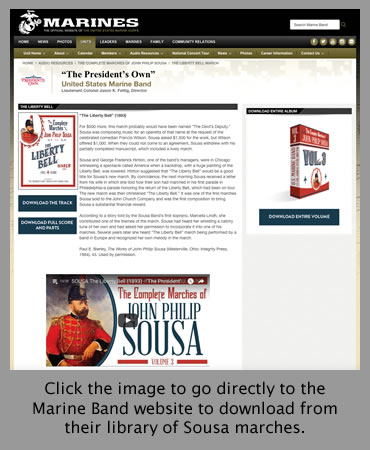Monday, February 13, 2017
IN THIS ISSUE:
FREE Sousa Marches | Marching Machine Resonator Box | Clarinet Tonguing Tips
Download John Philip Sousa Marches for FREE!
 The United States Marine Band "The President's Own" website has a section devoted to the marches of John Philip Sousa. You can listen to recordings of each march and download the score and parts for FREE. Click this link for more information.
The United States Marine Band "The President's Own" website has a section devoted to the marches of John Philip Sousa. You can listen to recordings of each march and download the score and parts for FREE. Click this link for more information.
From the Marine Band website:
"The Complete Marches of John Philip Sousa" is a multi-year recording project and is the Marine Band's first comprehensive collection of Sousa's marches since the 1970s. Initiated by Director Lt. Col. Jason K. Fettig, the collection is presented in chronological order. Volume 1, released on April 6, 2015, contains Sousa's first 17 marches, covering the years 1873 to 1882. Volume 2, released on April 11, 2016, contains 18 marches, spanning the years 1883 to 1889, when Sousa was Director of the Marine Band. Volume 3, released Dec. 12, 2016, includes 20 marches Sousa composed from 1889-98.
The volumes are available for free download exclusively on the Marine Band website, along with scrolling videos and PDFs of the full scores that include historical and editorial notes about each piece. Each march has been carefully edited and corrected by Lt. Col. Fettig and Music Production Chief Master Gunnery Sgt. Donald Patterson using some of the earliest known publications and incorporate performance practices employed by the Marine Band that are modeled on those of "The March King" himself.
Check out this Resonator Box for a Marching Machine
Bryant Knapp from Summit Lakes Middle School in the Lee's Summit school district created a very effective resonator box for their marching machine. The result was much greater projection and depth of sound. Click on the image below to see a video of his creation!

 Four Concepts to Remember When Tonguing on the Clarinet by Mallory Tittle
Four Concepts to Remember When Tonguing on the Clarinet by Mallory Tittle
This article was contributed by D'Addario. For more information, visit thewoodwindmethod.com.
Tonguing is one of the required fundamentals when playing a wind instrument. It's how wind players separate notes, like string players stopping their bow stroke to separate notes.
When tonguing on the clarinet, it is important to:
1. Keep the airstream CONSTANT. No matter if the tongue is on the reed or not, that should not affect the airstream. The airstream should be thought of like water coming out of a sink. The water is constantly flowing, like the airstream should always be constant. The tongue is only an interruption to the constant airstream.
2. The tongue movement is a RELEASE off the reed, not an ATTACK on the reed. Sound is produced when the tongue leaves the reed. The tongue comes back to the reed to stop the sound.
3. The tongue should touch the area below the tip of the reed. This area on the reed is the area that vibrates when we play (from the tip to the heart). If the tongue touches the direct tip of the reed, this will result in a sound that can be too "pecky." If the tongue touches the heart or below, there will not be any vibration which results in an unclear sound when tonguing.
4. The tongue position in your mouth should be high, like saying "ee." Tongue position is very important not with just tonguing, but with getting that ideal tone that you want. Another way to find this proper position is to hiss like a cat. This demonstrates the high tongue position, along with a fast airstream. With a proper tongue position, it makes concept 3 easier to achieve.
Contact Your Local Palen Music Center Representative
Can we assist you with
anything? Please contact your local Palen Music Center school road
representative for all of your music education needs.
